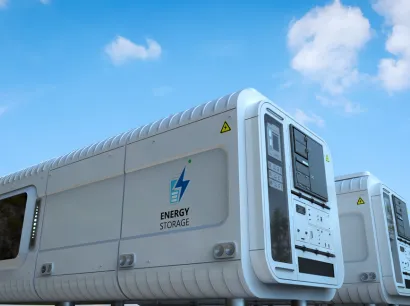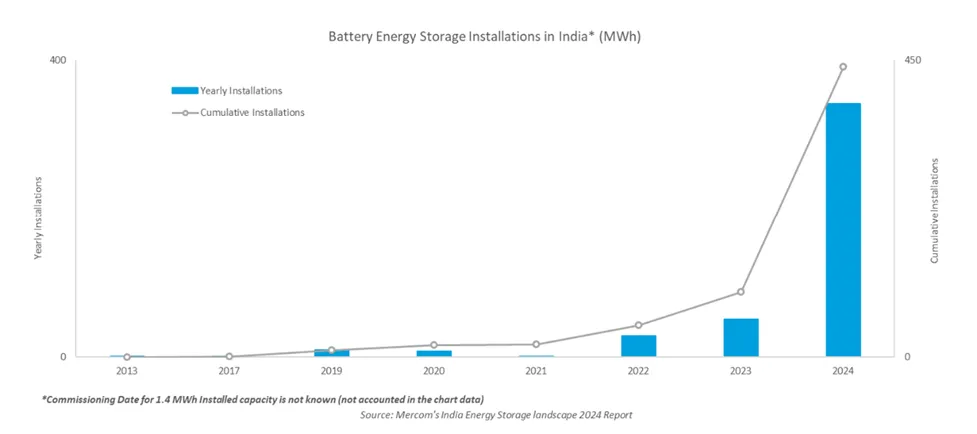
Battery Energy Storage Systems (BESS) are fast becoming the key enabler in India’s renewable energy transition. As the country adds large volumes of solar and wind, the next phase is not just clean electricity – but clean power that is also reliable and available Round-the-Clock. This is where BESS plays a pivotal role. It stores surplus energy generated during the day and releases it during evening hours or at times of peak demand. In simple terms, BESS converts intermittent renewable energy into power that can be scheduled.
Inside the Battery: The Science Driving Modern Energy Storage
The basic science behind BESS is straightforward: it absorbs electricity when available and releases it when required. During charging, energy from solar or the grid is stored chemically inside battery cells. When power is needed later – for example, during peak tariff hours – this stored chemical energy is converted back to electrical power.
A Battery Management System (BMS) continuously monitors temperature, voltage and cell performance to ensure safe operation, prevent overcharging/over-discharging and maximise battery life.
Most grid-scale storage systems today use Lithium-ion technology because of its high energy density, fast response times and longer lifecycle compared to traditional batteries.
In BESS:
- power = kW/MW (how fast it can charge/discharge)
- energy = kWh/MWh (how much total energy it can store and supply)
Curious on how BESS works with a visual representation?
Check out this link- https://www.fourthpartner.co/battery-energy-storage-systems/
Why is the focus rising on Battery Storage by the Government and Industries?
India is adding massive solar and wind capacity every year. But without storage, this power is intermittent and not fully dispatchable. Government bodies, grid operators and industries now recognise that BESS is essential to make renewables firm and reliable.
Key demand drivers:
- Clear Government push via Storage Obligation and VGF support for BESS.
- Corporates now demand RTC green power, not just daytime RE; BESS enables this.
- Peak tariffs are driving industries to store cheaper power and use it during high-cost hours.
- BESS strengthens long-term Net Zero strategy by increasing RE share in consumption.
As Green Open Access and RTC PPAs scale, storage will move from optional to standard – making BESS central to battery energy storage system India adoption.
Battery Storage: Scenario and Policy Landscape in India
India installed over 341 MWh of BESS in 2024, marking an over sixfold increase from the 51 MWh installed in 2023.
CEA estimates India will need 411.4 GWh of storage by 2031–32, with 236 GWh expected from BESS alone.
Government support includes:
- ₹91 Bn VGF for 43.2 GWh of storage
- A new ₹5,400 crore scheme for 30 GWh
- ISTS waiver till June 2028 for co-located RE + BESS
- PLI support for 50 GWh ACC battery manufacturing
Corporate funding reached US$ 174 Mn in 2024 and the sector is projected to attract ₹4.79 lakh crore by 2032.
With this alignment of policy, capital and corporate demand, India is set to become one of the world’s most dynamic Battery Energy Storage System India markets this decade.

Rooftop Solar Plant for HUL
The Integrations powering up BESS to the next level
Two major integrations will accelerate BESS scale and value:
Battery Storage + Open Access Renewable Energy
Open Access RE parks already operate at higher capacity. When combined with BESS, corporates can significantly reduce dependence on expensive grid power. This enables cost predictability under ToD tariffs, strengthens business continuity and accelerates Net Zero roadmaps.

Infographic Source: CEEW
AI-enabled BESS
AI-driven platforms will optimise BESS by analysing weather forecasts, load curves and real-time price fluctuations. This improves utilisation, reduces lifecycle cost and enables predictive maintenance. With AI, BESS evolves into a smart asset that continuously self-optimises.
Fourth Partner Energy’s Battery Energy Storage Systems footprint
Fourth Partner Energy has been an early mover in BESS deployment across multiple States and industrial sectors. We have an in-house vertical dedicated to deploying BESS solutions, in addition to our RE solutions to help corporates maximise their clean energy adoption, as well as savings.
Our installed BESS portfolio is over 60 MWh, powering clean energy reliability for 30+ corporate clients, including marquee names such as Flipkart, Metro Cash and Carry, and NTPC NETRA.

Fourth Partner Energy’s 4 MWp Solar + 1 MWhr BESS installation at NTPC NETRA, Noida
FPEL’s goal is to deliver dependable storage-backed energy solutions that reduce peak charges, improve power quality and make clean power more productive for Indian industries.
Ready for Round-the-Clock green power?
Talk to us about deploying BESS for your business operations by writing to marketing@fourthpartner.co
FAQs
Is BESS safe for industrial deployment?
Yes. Modern BESS comes with multiple safety layers including battery management systems, cooling, fire protection and remote monitoring to ensure safe operation.
How does BESS enable RTC power?
Solar is daytime-heavy. BESS stores this surplus energy and supplies it later, making clean power steady, predictable and round-the-clock.
Does BESS help in reducing cost?
Yes. By shifting consumption away from peak tariff hours and also by reducing dependency on grid, BESS brings down the final cost per unit of electricity.
How fast is BESS adoption in India?
Very fast. As industries commit to Net Zero targets and 24×7 clean power, battery energy storage system India adoption is accelerating rapidly and becoming a core part of industrial energy strategy.
Where do we see highest demand for BESS?
Data centres, manufacturing clusters and large commercial campuses where reliability, backup and RTC clean power supply are critical.




